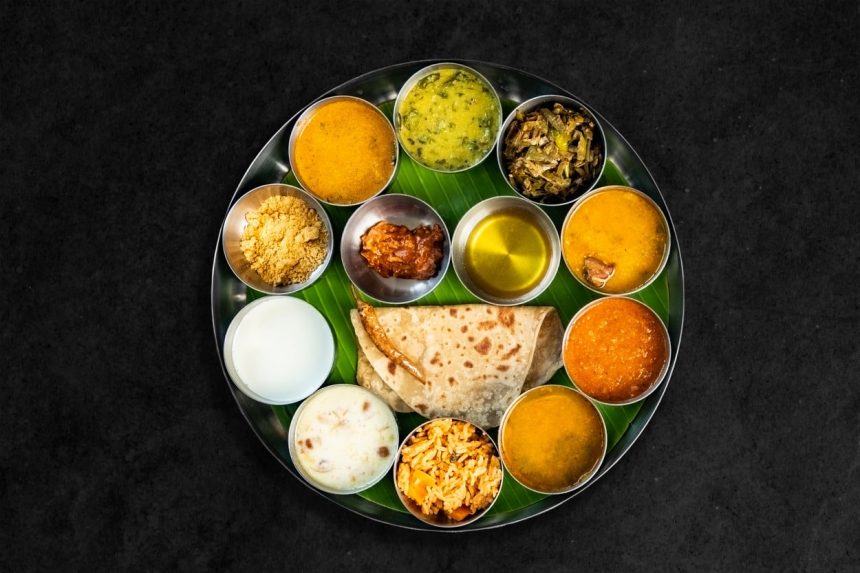In a world saturated with information and literature on dietary trends and nutritional advice, Desi cuisine often finds itself under scrutiny. It never matches up to the reputation of its non-Desi counterparts. Also, there are several misconceptions about Desi cuisine. The common ones are that they are unhealthy, greasy, lack nutrients and cannot make one fit. But underneath its ordinary appearance, there’s a variety of delicious flavours, cultural traditions, and nutritional goodness waiting to be discovered and enjoyed.
Common Misconceptions About Desi Foods
People often misunderstand desi food, thinking it’s always hot and spicy or too oily and rich, making it seem unhealthy for your diet. Some may also believe that cooking Indian dishes is difficult and time-consuming, especially when looking at recipes with long lists of ingredients. But these are all misconceptions.
Just like any other cuisine, desi food is diverse. You can find spicy or mild recipes, and some dishes take a long time to make, while others can be cooked up in a few minutes. Here are some other common myths and misconceptions surrounding desi food.
Myth 1: All Desi Food is Fatty and Unhealthy
The fat content in desi food is a matter of personal choice. You have the flexibility to use six tablespoons of oil in a dish or settle for two, depending on your preference. Moreover, numerous dishes require no oil at all, relying on methods such as roasting, steaming, grilling, or boiling.
Numerous recipes encourage the use of fresh produce and incorporate healing spices like turmeric, ginger, pepper, or garlic. Opting to prepare certain meals from scratch, like a Rajasthani Thali, may take time, but it reduces your dependence on the preservatives commonly found in packaged and pre-prepared foods.
Myth 2: All Desi Food is High Calorie
A common misconception is that all Desi foods are high in calories and unhealthy. While certain Desi dishes may contain high levels of sugar, fats, and carbohydrates, many traditional recipes include nutrient-dense ingredients such as lentils, vegetables, and spices. These components not only provide health benefits but are also low in calories.
Myth 3: Desi Food Shows Lack of Variety
There’s a common belief that Desi foods consist mainly of staple dishes like rice, dal, roti, and sabzi. However, Desi cuisine is remarkably diverse, with each region offering a variety of dishes, seasonal vegetables, and recipes that include options for vegetarians, non-vegetarians, and vegans.
Indian vegetarians often incorporate animal-based products like paneer, dahi, or ghee into their meals. However, a wide variety of vegan Indian food options is readily available. Masala Dosa, Veg Pulao, Dal, Chole, Pakode, Chana Masala, and Rajma are just a few examples of wholesome vegan Desi meals.
Myth 4: Unsuitable for Dietary Restrictions
Some assume that Desi foods are unsuitable for people with dietary restrictions, such as weight loss diets or gluten-free or dairy-free diets. However, many Desi recipes accommodate various dietary preferences and restrictions without compromising taste or authenticity.
The health factor of desi food depends entirely on the choices you make. Given how tempting most Desi foods are, it’s easy to fall into the temptation of a second helping of Jalebi or Gulab Jamun. HealthifyMe nutritionists can guide you on portion control. Even if you indulge in a second serving of a sugary snack, the HealthifyMe CGM device can monitor your blood glucose levels. If there’s a concerning shift, the nutritionists receive an alert and can actively suggest measures to balance your blood sugar.
Myth 5: Lack of Nutrients, Especially Protein
There’s a misconception that Desi foods lack essential nutrients, particularly protein, and are predominantly carbohydrate-rich. This perception often overlooks the diverse sources of protein in Desi cuisines, such as lentils, chickpeas, paneer (cottage cheese), yoghurt, and various types of fish and meats.
Myth 6: Unhealthy Cooking Methods
Another misconception is that Desi Foods employs unhealthy cooking methods such as deep frying or excessive oil use. While some dishes may involve frying, many traditional Desi recipes opt for healthier methods like grilling, steaming, and sautéing with minimal oil.
Summary
Contrary to popular belief, Desi cuisine offers a wide range of options, from spicy to mild, and features dishes that cater to various dietary preferences. The truth is that Desi cuisine, like any other, is diverse, offering a range of flavours, cooking methods, and nutritional choices. Many traditional recipes include nutrient-dense and protein sources like lentils, chickpeas, paneer, yoghurt, and various types of fish and meats. By making informed choices and opting for cooking methods like grilling, steaming, and sautéing with minimal oil, you can enjoy the authenticity of Desi foods while prioritising your health.
The Health Benefits of a Traditional Desi Diet
Traditional Desi food is not just delicious but also exceptionally healthy, offering numerous health benefits, including:
High-Fibre Content
Desi foods, like lentils (dal), chickpeas (chana), and whole grains such as brown rice, broken wheat and quinoa, are naturally rich in fibre. It promotes satiety, controls appetite, aids digestion, and regulates blood sugar levels, preventing overeating and cravings.
Traditional Desi meals focus on including dietary fibre through everyday foods. Whole wheat flatbreads, a common part of Desi cuisine, are made with whole wheat flour, offering a good source of fibre. Dal and spinach, commonly used in desi dishes, not only add texture but also provide a healthy dose of fibre.
Lean Protein Sources
Desi cuisine provides various lean protein options essential for maintaining muscle mass and weight loss. Protein stands out as one of the most thermogenic nutrients, meaning it burns more calories than fat and carbohydrates. Therefore, a higher protein intake boosts metabolism. When combined with a balanced diet and proper exercise, it can lead to effective fat loss.
Lentils, legumes, paneer (cottage cheese), and lean cuts of poultry and fish are all excellent protein sources. Lentils, whether Arhar, Urad, or Moong dal, are a common and simple addition to almost every Desi meal. These high-protein vegetarian options in Indian cuisine become a wholesome meal when paired with roti or rice.
Healthy Cooking Methods
Traditional Desi cooking involves minimal oil usage and emphasises techniques like steaming, grilling, and sautéing. These methods reduce calorie intake while preserving the natural flavours and nutrients of ingredients, contributing to weight loss. Tandoori cooking, stir-frying, and steaming are popular, health-conscious techniques.
Abundance of Plant-Based Options
Desi cuisine offers numerous plant-based options, such as vegetable curries, lentil soups, and salads, which are low in calories and rich in nutrients. These choices are ideal for weight loss and increasing vitamin and antioxidant intake.
Much of South Indian cuisine is inherently vegan. Whether enjoying Podi Idlys in Chennai or Mysore Dosas from Karnataka, many dishes are vegan by default, requiring only the omission of ghee. Coastal areas like Kerala and Mangalore may lean towards pescatarian options, yet coconut milk-based curries and flavoured rice dishes are readily available and naturally vegan.
Spices and Herbs with Metabolic Benefits
Desi spices and herbs, including turmeric, cinnamon, cumin, and ginger, not only enhance flavour but also support metabolic function and immunity. For instance, ginger tea can effectively ease symptoms of motion sickness, like dizziness, vomiting, and cold sweats.
In Indian cooking, a vital ingredient is a mix of spices called garam masala. Although the main ingredients are the same, every home has its way of using garam masala. This personal touch results in varying flavours, making every home-cooked dish special.
Turmeric is a staple in Indian dishes not just for its flavour but also for its immune-boosting properties. The active component, curcumin, possesses anti-inflammatory, antiseptic, and antibacterial properties. It’s a common practice in many Indian households to drink a glass of turmeric milk at night.
Turmeric, ginger, and cinnamon, the key components of golden milk, show anti-inflammatory properties that can alleviate inflammation and joint pain. Turmeric, with its potent compound curcumin, has the potential to enhance heart health and prevent conditions like Alzheimer’s and cancer.
Portion Control and Mindful Eating
Traditional Desi eating practices stress mindful eating and portion control. Consuming meals slowly, savouring each bite, and paying attention to hunger cues prevent overeating. Additionally, enjoying meals in a communal setting fosters satisfaction and a healthier relationship with food, contributing to overall well-being.
Summary
Desi cuisine incorporates high-fibre lentils, chickpeas, and whole grains, aiding in satiety, digestion, and blood sugar regulation. Lean protein sources such as lentils, legumes, paneer, and lean cuts of poultry and fish contribute to muscle maintenance and effective weight loss when combined with a balanced diet and exercise. With minimal oil usage and techniques like grilling and sautéing, Desi cooking maintains flavours while reducing calories. South Indian dishes are naturally vegan. Spices like turmeric and ginger add flavour and metabolic benefits. Desi eating also encourages mindful consumption, preventing overeating and promoting a healthier relationship with food.
Desi Alternatives to International Superfoods
Many fitness enthusiasts often endorse imported fruits and vegetables, yet there are lesser-known Desi superfoods that offer comparable nutrition at a more affordable price and easier accessibility. Rather than getting caught up in the diet trends promoted on social media with exotic foods, consider switching to Desi superfood alternatives. Here is a list of Desi substitutes for international superfoods that are rich in essential nutrients.
1. Spinach Instead of Kale
Though kale and spinach are different, you can swap them in any recipe. If you use spinach instead of kale, the dish will be milder and without kale’s bitter edge. Kale has more calories, calcium, iron, magnesium, vitamin C, niacin, pantothenic acid, and vitamin B6. Spinach, however, has more water, protein, dietary fibre, vitamin A, potassium, manganese, thiamin, and riboflavin. So, whether it’s kale or spinach, you can switch things up while still getting unique nutrients.
2. Amaranth for Quinoa
Amaranth or Rajgira is a good option for those seeking a nutritious alternative to quinoa. This pseudocereal is a powerhouse of plant-based protein, offering essential amino acids. Gluten-free and packed with dietary fibre, amaranth promotes digestion and overall gut health. While quinoa has a higher protein content, amaranth is rich in minerals like calcium and iron. Amaranth also contains niacin, folate, vitamin A, vitamin C, and vitamin K.
3. Banana for Avocado
Avocados are super healthy, but they can be pricey and not easily accessible for everyone. That’s where bananas step in as the perfect Indian superfood alternative. Packed with dietary fibre, vitamin C, vitamin B6, and potassium, bananas are great for digestion, soothing heartburn, and maintaining electrolyte balance. Just like avocados, you can enjoy bananas raw, add them to smoothies, or top your breakfast cereals or yoghurt for a tasty and nutritious treat.
4. Indian Gooseberry for Acai Berries
Amla stands as a classic in Indian cuisine and Ayurvedic traditions. With its tart aftertaste, Amla is versatile and can be enjoyed fresh, dried, or as a juice, adding a nutritious touch to Desi cuisine. Known for its exceptionally high vitamin C content, Amla also provides dietary fibre, antioxidants, including vitamin C, tannins, and flavonoids,
5. Jamun instead for Blueberries
Both jamun and blueberries have rich antioxidant content, which helps prevent oxidative stress and cellular damage. Jamun, with its polyphenols, flavonoids, and anthocyanins, supports immune function, collagen synthesis, and antioxidant activity. Jamun’s distinctive sweet and tangy flavour perfectly complements jams, jellies, juices, and desserts.
Summary
The nutritional richness of Desi superfood alternatives offers affordability and accessibility compared to imported counterparts. Swap spinach for kale, benefiting from spinach’s milder taste and diverse nutrient profile. Choose amaranth over quinoa for a gluten-free, fibre-packed option with essential amino acids. Opt for bananas instead of avocados, enjoying their digestive benefits and potassium content at a fraction of the cost. Amla, with its high vitamin C and antioxidant content, competes with Acai berries, adding a Desi touch to nutrition. You can also pick jamun over blueberries for antioxidants and a delightful sweet-tangy flavour.
Sample Meal Plans With Desi Foods
These meal ideas provide a good balance of proteins, carbohydrates, and essential nutrients while keeping the focus on Desi foods:
Non-vegetarian Meal Plan for a Day
- Breakfast: 1 bowl of Poha or Upma
- Lunch: 2-3 chapatis or a small bowl of rice with vegetables, 1 cup low-fat yoghurt, fish curry
- Snack: 1 bowl sprouts chaat, Adrak chai
- Dinner: Malabar chicken curry with 2 rotis
Vegetarian Meal Plan for a Day
- Breakfast: Paratha with yoghurt, aloo gobi
- Lunch: Rajma (kidney bean curry) with brown rice, Cucumber and carrot salad
- Snack: Fresh fruit (e.g., a large banana, 1/2 cup grapes, papaya), Coconut water
- Dinner: Roti (whole wheat bread) with palak paneer
Vegan Meal Plan for a Day
- Breakfast: Idli with sambar, black tea
- Lunch: Tender coconut water(1 glass), chana chaat
- Snack: Roasted seeds or a handful of nuts or 1 bowl sprouts chaat
- Dinner: Stuffed paratha with tomato chutney
The HealthifyMe Advantage
HealthifyMe is like having a nutrition expert in your pocket, making eating healthy simple and fun. With our easy-to-use app, getting advice on what to eat for your health goals is as simple as taking a picture of your meal. We take a close look at everything that matters for your health: how tall you are, how much you weigh, what you usually eat, and even how foods taste to you. If you have trouble swallowing or certain foods don’t sit well with you, HealthifyMe takes note of that, too.
HealthifyMe’s smart nutritionist, Ria, uses all the info from people’s diet and exercise logs to give you tips that fit your lifestyle and food likes. Plus, your human coaches are there to help guide you. HealthifyMe Snap keeps an eye on your daily routine, blood sugar, the food you’re eating (just snap a pic!), how active you are, and what you like to eat. This way, you get a health plan that’s just right for you, making it easier to stick to your goals and keep track of how you’re doing.
HealthifyMe Suggestion
Indian millets such as foxtail millet, finger millet, and pearl millet are being picked up as nutritious alternatives. They are gluten-free, high in fibre, and full of important nutrients. Ragi, for example, is high in calcium, making it a great choice for improving bone health. Enjoy millets such as porridge, upma, or dosas for a nutritious meal. Kanji is a traditional fermented and tarty probiotic super drink that helps with gut health and is rich in many nutrients. Sabja seeds are a rich source of fibre; they help regulate blood sugar levels and promote fullness and satiety. Look around and incorporate the Desi foods around you to gain the benefit.
The Final Word
Desi cuisine often faces misconceptions, with some believing it’s unhealthy, greasy, or lacking nutrients. Contrary to myths, Desi food offers variety, accommodating preferences for spice levels. It’s not universally fatty or high-calorie, and there’s a misconception about a lack of variety. Desi cuisine can cater to dietary restrictions, and it provides ample nutrients, including protein from sources like lentils and chickpeas.
While some dishes involve frying, many use healthier methods like grilling and steaming. Traditional Desi diets have health benefits, emphasising fibre, lean proteins, and mindful eating. With a focus on science and personalisation, HealthifyMe ensures that users can enjoy their traditional foods while maintaining a balanced and healthy lifestyle.
Disclaimer: The purpose of this article is just to disperse knowledge and raise awareness. It does not intend to replace medical advice from professionals. For further information, please contact our certified nutritionists Here.
Research Sources
Indian Spices for Healthy Heart – An Overview
Frequently Asked Questions (FAQs)
Q: Are traditional Desi foods unhealthy?
A: The healthiness of the same Desi dish can vary based on how you choose to prepare and consume it. Factors such as frying, excessive sweetness, ready-to-cook items with preservatives, and the use of unhealthy fats can contribute to making a dish less healthy. Multiple reasons exist for deeming a food unhealthy, but ultimately, it’s within your control to decide how you want to make and enjoy it. Making mindful choices about ingredients, cooking methods, and portion sizes allows you to create healthier versions of your favourite Desi dishes.
Q: Do all Desi dishes contain excessive amounts of oil and spices?
A: The use of oil and spices in Desi dishes varies based on personal preferences and recipes. While some dishes include a significant amount of oil and spices for flavour, many others are prepared with moderation in mind. Additionally, some dishes utilise healthier cooking methods like grilling, steaming, and sautéing.
Q: Is it true that Desi foods are solely responsible for weight gain?
A: Weight gain depends on various factors, including overall dietary habits, lifestyle, and physical activity. One particular cuisine or food type is not the sole causative factor of weight gain. With mindful choices and portion control, it is possible to enjoy Desi cuisine as part of a weight-loss diet.
Q: Are Desi sweets always harmful to health?
A: Incorporating local ingredients such as coconut, pulses, millets, and nuts in Desi sweet enhances its healthiness. Some Indian sweets, like Laddoos or Modaks made with jaggery (unrefined cane sugar), can be a healthier option compared to those made with refined sugar. It’s important to note that there is no specific nutritional guide for Indian sweets, as their nutritional content varies based on the type and preparation method. To maintain a balanced diet, enjoy sweets in moderation rather than relying on them for specific health benefits.
Q: Do Desi foods lack nutritional value compared to Western cuisine?
A: The nutritional quality of meals in both Desi and Western cuisines varies depending on factors like portion sizes, cooking techniques, and ingredient choices. For instance, a well-balanced Desi meal incorporating a mix of vegetables, lentils, and whole grains can be as nutritious as a well-balanced Western meal. It’s important to understand that the overall composition of a diet, rather than its cultural or regional origin, determines its nutritional value.
Q: Are all Desi foods difficult to digest?
A: While some traditional Desi dishes may indeed be rich, spicy, or oily, it’s essential not to forget the diversity within Desi cuisine. Many Indian dishes are easily digestible and can be gentle on the stomach. Dal khichdi, buttermilk (chaas), or curd rice are excellent examples of easily digestible Indian foods. These dishes are often ideal for individuals with sensitive digestive systems or those looking for lighter meal options.
Q: Are vegetarian Desi meals deficient in protein?
A: No, because vegetarian Desi meals often contain various plant-based protein sources, including lentils, chickpeas, beans, and paneer (Indian cottage cheese). While meat is a common source of protein, a well-balanced and well-planned vegetarian diet can provide ample protein.
Q: Is it accurate to say that Desi food is not suitable for individuals with dietary restrictions or allergies?
A: No, Desi cuisine offers a diverse range of dishes to meet various dietary needs. It caters to different dietary preferences, including healthy and nutritious options for vegetarians, vegans, and those with gluten sensitivities. However, clear communication about dietary restrictions or allergies while preparing is necessary to avoid any ingredients that may pose a risk.
Q: Do all Desi dishes contribute to high cholesterol levels?
A: Deep frying, a popular cooking method in some Desi recipes, can contribute to high cholesterol when done excessively. Certain traditional Desi dishes may contain ingredients high in fats, sugars, or salt. However, cholesterol levels in Desi food depend on factors like ingredients, cooking methods, and portion sizes. Maintaining moderation and making mindful ingredient choices are crucial for promoting a well-rounded and nutritious approach to Desi cuisine or any other cuisine.
Q: Are Desi cooking methods always unhealthy?
A: No, Desi cooking methods are not always unhealthy. It depends on the choices you make, such as the ingredients and techniques you choose to cook Desi foods. Grilling, steaming, and sautéing are relatively healthy cooking methods in Desi cuisine.







